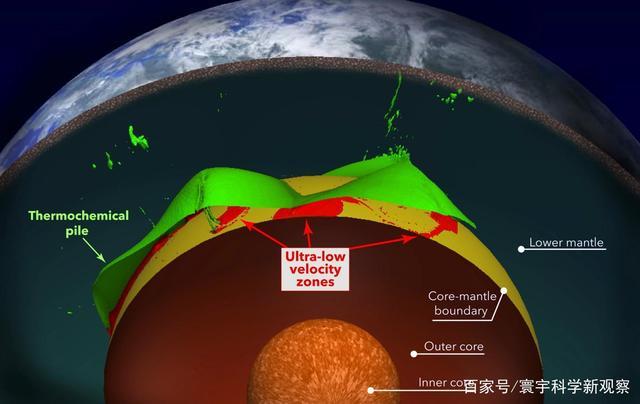
Describe the Convection Currents in the Outer Core
The Earth’s outer core is a mysterious and dynamic layer, primarily composed of molten iron and nickel. It is here that convection currents play a crucial role in shaping the planet’s magnetic field and influencing geological processes. In this detailed exploration, we delve into the intricacies of these convection currents, their formation, and their impact on the Earth’s dynamics.
Formation of Convection Currents
Convection currents are driven by the temperature and density differences within the outer core. The core, being in a liquid state, responds to these variations by moving in a circular motion. The process begins with the heat generated from the Earth’s interior, which causes the molten metal to expand and become less dense. As this hot, less dense material rises towards the core-mantle boundary, it cools down and becomes denser, eventually sinking back towards the center of the Earth.

This continuous cycle of rising and sinking creates convection currents, which are responsible for the dynamic movement of the outer core. The temperature differences within the core are primarily caused by the heat from the Earth’s interior, which varies with depth. The density differences arise from the varying composition of the molten metal, with iron being more abundant than nickel.
Impact on the Earth’s Magnetic Field
Convection currents in the outer core are closely linked to the Earth’s magnetic field. The movement of the molten metal generates electric currents, which in turn create a magnetic field. This process, known as the geodynamo, is responsible for the Earth’s magnetic field, which protects the planet from harmful solar radiation and cosmic rays.
The convection currents in the outer core are not uniform; they vary in intensity and direction. This variation leads to the formation of magnetic field lines, which extend from the Earth’s interior to space. The Earth’s magnetic field is not static; it undergoes changes over time, known as geomagnetic reversals. These reversals are believed to be caused by the changes in the convection currents within the outer core.
Influence on Geomagnetic Reversals
Geomagnetic reversals are a fascinating phenomenon that occurs when the Earth’s magnetic field flips its poles. This reversal is believed to be driven by the changes in the convection currents within the outer core. When the convection currents weaken, the magnetic field becomes unstable, leading to a reversal.
Several factors contribute to the changes in the convection currents, including the Earth’s rotation, the composition of the outer core, and the heat flow from the interior. These factors can cause the convection currents to become less efficient, leading to a decrease in the magnetic field strength. Eventually, the magnetic field becomes so weak that it flips, resulting in a geomagnetic reversal.
Understanding the mechanisms behind geomagnetic reversals is crucial for predicting the behavior of the Earth’s magnetic field. This knowledge can help scientists assess the potential risks associated with geomagnetic reversals, such as increased cosmic radiation exposure and the impact on technological systems.
Convection Currents and Geology
Convection currents in the outer core also have a significant impact on geological processes. The movement of the molten metal can cause the Earth’s crust to deform and shift, leading to the formation of mountains, earthquakes, and volcanic activity.
One of the most notable examples of this relationship is the Mid-Ocean Ridge system. This underwater mountain range is formed by the upwelling of molten material from the mantle, driven by the convection currents in the outer core. As the material rises, it cools and solidifies, creating new oceanic crust and extending the Mid-Ocean Ridge.
Additionally, the convection currents can influence the movement of tectonic plates. The heat from the outer core can cause the mantle to flow, leading to the subduction of oceanic plates and the formation of mountain ranges. This process is responsible for the creation of the Andes Mountains in South America and the Himalayas in Asia.
Conclusion
Convection currents in the outer core are a vital component of the Earth’s dynamic system. They drive the geodynamo, generate the Earth’s magnetic field, and influence geological processes. Understanding the intricacies of these currents is crucial for unraveling the mysteries of the Earth’s interior and predicting the behavior of the planet’s magnetic field. As scientists continue to study these convection currents, we gain a deeper insight into the complex and fascinating dynamics of our planet.




